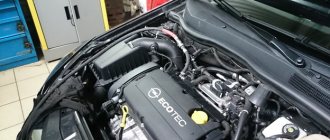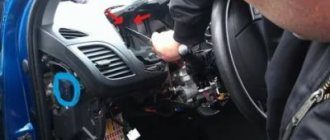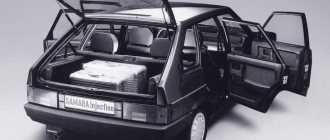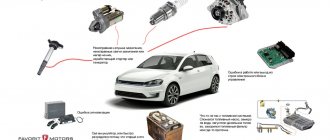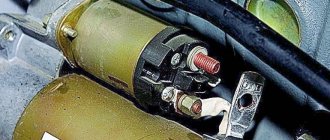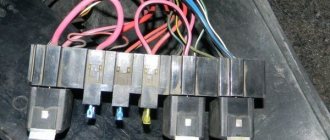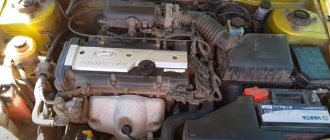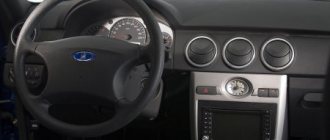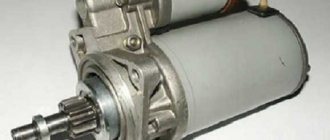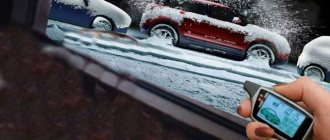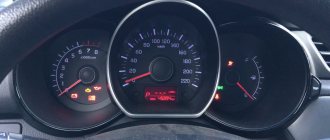Turning the ignition key, the driver observes the same picture every time. First, the instrument panel indicators light up to indicate the presence of fuel and battery charge. In the extreme position, the starter turns on and begins to rotate the crankshaft. To start a serviceable engine, a few crankshaft revolutions are enough, but what to do when the starter works, but the car stubbornly refuses to start? The culprit for this situation can be a variety of malfunctions, because the normal operation of the engine is ensured by several automotive systems at once.
Immobilizer enabled
What happens: the starter turns confidently, but the engine does not start.
After installing the alarm, control of the immobilizer passes to it. Sometimes, due to equipment failures or accidental presses on the key fob in your pocket, the anti-theft protection is activated. Depending on the circuit and the selected settings, the immobilizer blocks the fuel pump, injectors, ignition system or even the starter. In any case, the engine will not start.
What to do: if you accidentally turned on the lock yourself, then try to remove it by finding out the required combination in the instructions or on the Internet. In case of alarm errors, only its installer or a competent auto electrician can deal with the problem.
Starter
A starter is a small electric motor that transmits the torque to the crankshaft necessary to start the engine. At the top of the starter there is a retractor relay, which is connected to the activation drive by a plug. When you turn the key in the ignition or press the start button, current from the battery is supplied to the starter, which starts the engine.
If the starter fails when you turn the key in the ignition, either clicking, buzzing, grinding or ringing sounds are heard from under the hood, or no sounds are heard at all.
The most common reasons for starter failure are: wear of brushes, bearings, drive gear jamming on the rotor splines, wear of the freewheel, oxidized or burnt contacts, short circuit of the windings.
You can check the operation of the starter by using a screwdriver to connect the thick starter terminal, to which the positive wire from the battery goes, with a small starter terminal, to which the thin wire goes. If the starter starts to rotate, then the starter control circuit, most often the ignition switch, is faulty. If the starter does not start to rotate, then the problem is in the starter itself and it needs to be repaired or replaced.
If you have access to the starter, you can try to simultaneously turn on the starter and lightly tap the solenoid relay with a wrench, which in some cases may work and the engine will start.
A car with a non-functioning starter will have to be taken to a car service center to have it repaired or replaced. You can try to push start a car with a manual transmission and drive to the service station under your own power. In most cases, the car is towed to a car service center or driven by a tow truck.
Low battery
What happens: the starter cranks the engine, but slowly. Dashboard lights dim or go dark.
Due to the low battery charge, the starter spins the engine insufficiently or with difficulty, and starting is out of the question. This happens after a long period of inactivity, especially in winter, when the problem is aggravated by thickened engine oil.
What to do: start the car by “lighting” it from a neighbor’s battery or in one of the other ways, and then charge or replace the battery.
Spark test
When the Check Engine light is on, the fuel pump is good, and the starter is working, the next thing to check is spark. To check it, you need to unscrew the spark plug, press it to ground and start the starter.
The check takes place one by one, on all cylinders. Such problems occur on many injection VAZ-2112 cars. The price of a new starter, by the way, is 2-3 thousand rubles.
Sources
- https://drajver.ru/tehobsluzhivanie/vaz-2112-ne-zavoditsya-prichiny.html
- https://autogearspb.ru/lada/vaz-2112-16-klapanov-ne-zavoditsya-prichiny.html
- https://gil-service.ru/ts/vaz-2112-ne-zavoditsya.html
- https://FokSevmash.ru/elektronika/ne-zavoditsya-vaz-2112-16-klapanov.html
- https://zapchasti.expert/reshenie-problem/ne-zavoditsya/ne-zavoditsya-vaz-2112.html
- https://delis-avto.ru/avto-ts/vaz-2112-16-ne-zavoditsya.html
- https://FB.ru/article/288870/vaz—ne-zavoditsya-prichinyi-i-ih-ustranenie
- https://www.vazzz.ru/pochemu-ne-zavoditsya-mashina-vaz-2112-inzhektor-16-klapanov/
- https://peretyajka-salona.ru/prochee/pochemu-ne-zavoditsya-vaz-2112-inzhektor-16-klapanov-prichiny-i-foto.html
[collapse]
Fuel system malfunctions
What happens: the engine rotates, but shows no signs of life.
Without fuel supply to the cylinders, the engine naturally will not start. If there is gasoline in the tank, then most often the reason for the lack of fuel in the combustion chamber is a clogged filter, a non-working fuel pump or its relay.
Impurities in low-quality fuel clog the filter element mesh, and gasoline does not flow further. In winter, it can become clogged with frozen water. Because of this, due to increased load, the fuel pump sometimes fails. It can also break due to overheating when driving with an almost empty tank, since the pump is cooled by fuel.
What to do: you can only check on your own whether the fuel pump is working. Turn on the ignition and listen. If everything is normal, then a buzzing sound should appear in the rear seat area for 5-10 seconds. If the pump works but no fuel flows, it means its screen is clogged.
To clean or replace the filter or fuel pump, you will have to remove the seat cushion, open the hatch in the floor and remove the pump housing. If you don’t have car repair skills, it’s better to contact a service center.
Why does the engine not start when the starter is working?
Many drivers have more than once encountered a situation where, after turning the key, the dashboard lights up regularly, signaling the presence of fuel in the tank and sufficient battery charge, but when the key is turned to the “engine start” position, the starter, instead of a couple of revolutions, continues to hum, rotating the crankshaft, but the engine does not start.
The reasons for this problem lie in malfunctions of one or more vehicle systems responsible for the normal operation of the engine.
Fuel system
Before entering the combustion chamber, fuel passes through several components of the fuel system: tank, pump, filter, injectors and throttle body. Let's look at all these components in order.
Tank. The fuel level in the tank is measured by a special sensor equipped with a float. If this mechanism malfunctions, the arrow on the dashboard may indicate the presence of fuel when the tank is completely “dry” - the engine cannot be started without fuel.
Pump . Depending on the type of engine and the fuel consumed, the pump can be located in the tank or in the area of the engine group. Designers of injection engines equip their products with an electric pump, the operation of which can be heard in the cab when you turn the key. Carburetor engines supply fuel to mechanical pumps that operate from a central shaft drive. The reasons why the device does not supply fuel may be wear of the electric motor brushes and other parts. Failure to start a diesel engine can also occur as a result of airing of the high pressure fuel pump or a malfunction of the silencing valve.
Fuel filter. After several unsuccessful attempts to start the engine, it is worth checking the condition of the fuel filter. This component does not allow water, dirt and other foreign matter to enter the engine. Failure to replace the filter in a timely manner leads to its complete clogging and blockage of fuel.
Injectors and throttle valve . In gasoline engines, fuel is mixed with air and enters the combustion chambers as a finished mixture. The intensity of the air supply is controlled by the throttle valve, which is driven by a mechanical drive or electric motor. A malfunction of the damper may cause the engine to fail to start. To supply diesel fuel to a group of cylinders, nozzles are used - complex and expensive mechanisms designed to pass strictly dosed portions of diesel fuel into the cylinders. Untimely maintenance of the vehicle and the use of low-quality fuel lead to clogging and failure of the injectors, as well as problems with starting the engine.
Ignition system and electronics
The components of the internal combustion engine ignition system include: battery, high-voltage wires, ignition coil, spark plugs. Also in modern cars, an important component of the ignition system is the electronic control unit (ECU), which receives signals from various sensors built into the engine and controls the operation of the vehicle systems.
Failure to start the engine can be caused by: low battery charge, breakdown of high-voltage lines, faulty ignition coil, spark plugs.
Diesel freezing
This is the jelly that forms inside the filter / patch.com
What happens: the engine simply does not start.
Fuel that is not appropriate for the season in diesel cars thickens greatly in the cold. The paraffins included in its composition precipitate, clogging the fine filter and fuel lines. All this causes the engine to not start.
What to do: return the diesel to fluidity. To do this, you need to warm up the car in a warm garage or pour a special antigel additive into the tank. Afterwards, drain or use up the remaining summer fuel and refuel with winter fuel.
Sometimes you can get by with little blood and use a hairdryer to warm up just the fine filter under the hood.
Other engine starting problems
In addition to the above malfunctions, there are a number of other problems. Their appearance may be due to various factors related to the conditions and manner of operation of the vehicle.
The car may not start due to:
- engine overheating;
- unjustified choice of fuels and lubricants;
- lack of fuel;
- clogging of exhaust system elements.
Problems with the ignition system
What happens: the starter turns, but the engine doesn’t even catch.
In the absence of a spark, the fuel-air mixture does not ignite and, accordingly, the engine cannot start. The reasons lie in broken ignition coils or wires, as well as spark plugs with a layer of soot or a cracked insulator.
What to do: the easiest way is to unscrew the spark plugs and visually assess the condition of the electrodes: they should be clean and dry. Next, put on the spark plug, attach the spark plug thread to the metal part of the engine and turn it with the starter. If there is a spark, then everything is in order with the ignition. If not, you need to try other spark plugs, and then check the wires and coils, also replacing them with known good ones.
Battery
The first thing you should look at is the battery. And it doesn’t matter whether we are talking about a hot injection engine or a cold one. It also doesn't matter at all how many valves it has. The batteries of all modifications of the VAZ model under consideration are of the same type.
To find out why the Lada does not want to start, open its hood and look at the battery indicator. If the latter is missing, measure the voltage with a tester - 11.5 volts will be normal. Lower readings indicate the need to charge. When this is not the reason, then look further. Be sure to check if the battery terminals are oxidized. If so, clean them with fine sandpaper.
Broken glow plugs
Hot spark plug tip / ScrewsNutsAndBolts YouTube channel
What's happening: The engine won't start and the spark plug light is on on the dashboard.
At low temperatures, fuel evaporates poorly, and without additional heating with glow plugs, diesel cars may simply not start. A malfunction is usually indicated by a constantly lit spiral indicator on the dashboard.
What to do: the spark plugs need to be removed, checked and faulty ones replaced. For the test, use a multimeter in dial mode. When the probes touch the central contact and the housing, a signal should sound.
You can also simply apply 12 V voltage from the battery to the spark plugs one by one. In 3–5 seconds, the electrode of a working spark plug should become red hot. The non-working one, accordingly, will remain dark.
A quick solution is to try to warm up the spark plugs several times and only then start the engine. They don't all fail at once, and if at least a couple works, that should help.
Sensor malfunctions
What happens: the starter turns, but the engine does not start. The Check Engine light is on on the dashboard.
All processes in the engine, including starting, are controlled in modern cars using an ECU. The “brains” read the readings of numerous sensors, and if any of them fails, the operation of the motor is disrupted or blocked. This is possible due to malfunctions of the crankshaft and camshaft position sensors, as well as idle speed, coolant temperature or detonation sensors.
What to do: identify and replace the defective unit. Unfortunately, only service specialists can do this. However, if you have an ELM327 scanner, you can try to find the problem yourself.
Timing belt broke
VAZ 2110 does not start, the starter turns - perhaps the reason lies in a broken timing belt?
The engine gas distribution mechanism is driven by the crankshaft gear. Initially, chains were used for this purpose, and timing belts, which began to be widely used about twenty years ago, aroused mistrust among car owners.
The undoubted advantages of a belt drive over a chain drive are its simple design, low weight and low noise. However, it is not without its drawbacks, the main one of which is the relatively short resource of the timing belt.
Of course, a faulty, torn or misaligned timing belt also causes the VAZ 2110 to fail to start. By the way, on stock, non-deformed models of the 21120 engine, a torn timing belt also causes valve deformation and requires additional repairs. In this case, driving even after replacing the belt without restoring the valves is impossible.
New timing belt VAZ 2110
Check for the presence of a spark in the spark plugs visually by turning on the ignition and pressing the outer metal part of the spark plug against the unpainted metal body of the car or against structural elements. Do not forget that all electrical parts of the product are under high voltage, so it is better to carry out work with insulating gloves. If there is no spark on only one spark plug, be sure to check the others and draw the appropriate conclusions.
The consequences of a broken timing belt depend entirely on the design of the power unit. To imagine what will happen at this moment, you need to turn to the mechanics of the internal combustion engine.
In a running engine, the pistons continuously move from one dead center to another. During the intake stroke, the piston moves down and the intake valve opens; during the exhaust stroke, the exhaust valve opens and the piston moves up. At the moment when the piston is at top dead center, all valves must be closed. If the timing belt breaks, the camshaft stops rotating and the valves stop in one position. At the same time, the crankshaft continues to rotate by inertia, and the pistons rush towards the open valves.
Timing belt VAZ 2110 OPEN
In some engines, for example, the 8-valve VAZ-2111, the pistons have special recesses to avoid contact with the valves in the event of a break. In this case, there will be no consequences, except that the car will not be able to get to the garage or workshop under its own power.
The starter turns, but the VAZ 2110, 2112, 2114 and 2115 do not start? List of reasons and sequence of actions
VAZ 2110 does not start, the starter turns Quite often, owners of domestic cars are interested in the question of why the starter turns, but the VAZ 2110, 2112, 2114 does not start. Such an unpleasant moment can occur at the most inopportune moment, at any time of the year, far from service centers or repair shops. It is advisable for each driver of these models to become familiar with the list of possible faults. This will allow you, in some cases, to independently find the problem that has arisen, and then fix it and continue operating the machine.
The starter turns, but VAZ 2110, 2112, 2114 and 2115 do not start. This happens most often in the cold season, and if there is no proper care and maintenance of the car, it can happen at any time. In this article we will try to consider in detail all possible problems with starting the engine at any time of the year. Such problems can occur with both carburetor models and injection power units.
Why doesn't the engine start?
Difficulties with starting or its impossibility can arise for a variety of reasons. The culprits should be looked for in the following devices:
- Fuel system malfunctions for all types of engines;
- Problems in the electrical equipment of the machine.
It should also be taken into account that starting the engine in cold weather is significantly different from carrying out this operation at above-zero temperatures. We will not touch upon problems with the battery and starter; we will assume that everything is in order with them, so we will focus only on the problems of the power unit.
Violation of valve timing
What happens: the starter turns easily, but the engine does not respond at all.
Due to incorrect adjustment or untimely replacement, the timing belt or chain can stretch and jump several teeth, or even break completely.
This inevitably leads to a violation of the valve timing: the valves do not close at the right time, compression and ignition of the mixture does not occur. Depending on the design of the engine, the pistons may reach the valves and bend them, causing costly repairs.
What to do: check the timing marks. If necessary, install them in accordance with the vehicle's operating instructions. For the future: always change the belt or chain according to the regulations and adjust correctly.
How does the engine start?
The internal combustion engine only operates if the following conditions are met:
- A sufficient amount of fuel and air mixture enters the engine cylinders.
- At the right moment (and to be precise, after the air-fuel mixture is compressed), the spark plug produces a high-power spark.
- The camshaft and crankshaft rotate at the required frequency, which is strictly selected. Only in this way does the gas distribution system work correctly and the chambers are filled with a combustible mixture in a timely manner.
When the driver turns the ignition key, voltage is applied to the starter relay, thereby activating the electric motor. Its function is to engage the flywheel with the crankshaft. Then the crankshaft begins to rotate, its angular momentum is converted into reciprocating movements of the pistons.
When the cylinders begin their work, this subsequently leads to the movement of the camshaft. The latter is needed in order to promptly open the valves to fill the combustion chambers with the mixture.
Camshaft
We recommend: Car won’t start: possible reasons
The internal combustion engine power system is responsible for the timely delivery of the combustible mixture. As soon as the piston moves to the upper compression point, high voltage is applied to the spark. Thus, when the mixture is ignited, a small explosion is created, the expanded gas affects the piston and it moves, moving the crankshaft. We have described the principle of starting an internal combustion engine; remember that engine modifications may be different, so the starting algorithm may differ.
Operation of an internal combustion engine
Flywheel ring offset
What's happening: the starter turns idle, you can hear a creaking and squealing noise from under the hood.
The teeth with which the starter bendix engages are not made on the flywheel disk itself, but on a removable rim - a crown. It fits tightly when heated and sometimes, in rare cases, can turn. In this case, the starter regularly rotates the crown, but the flywheel itself and, accordingly, the engine do not spin up.
What to do: remove the starter, engage 4th-5th gear, and then, using a screwdriver to lock the crown, push the car forward or backward a little. If the engine rotates separately from the crown, then the latter needs to be removed and replaced with a new one. Possibly together with the flywheel. The procedure is quite complicated and is performed at a service station.
